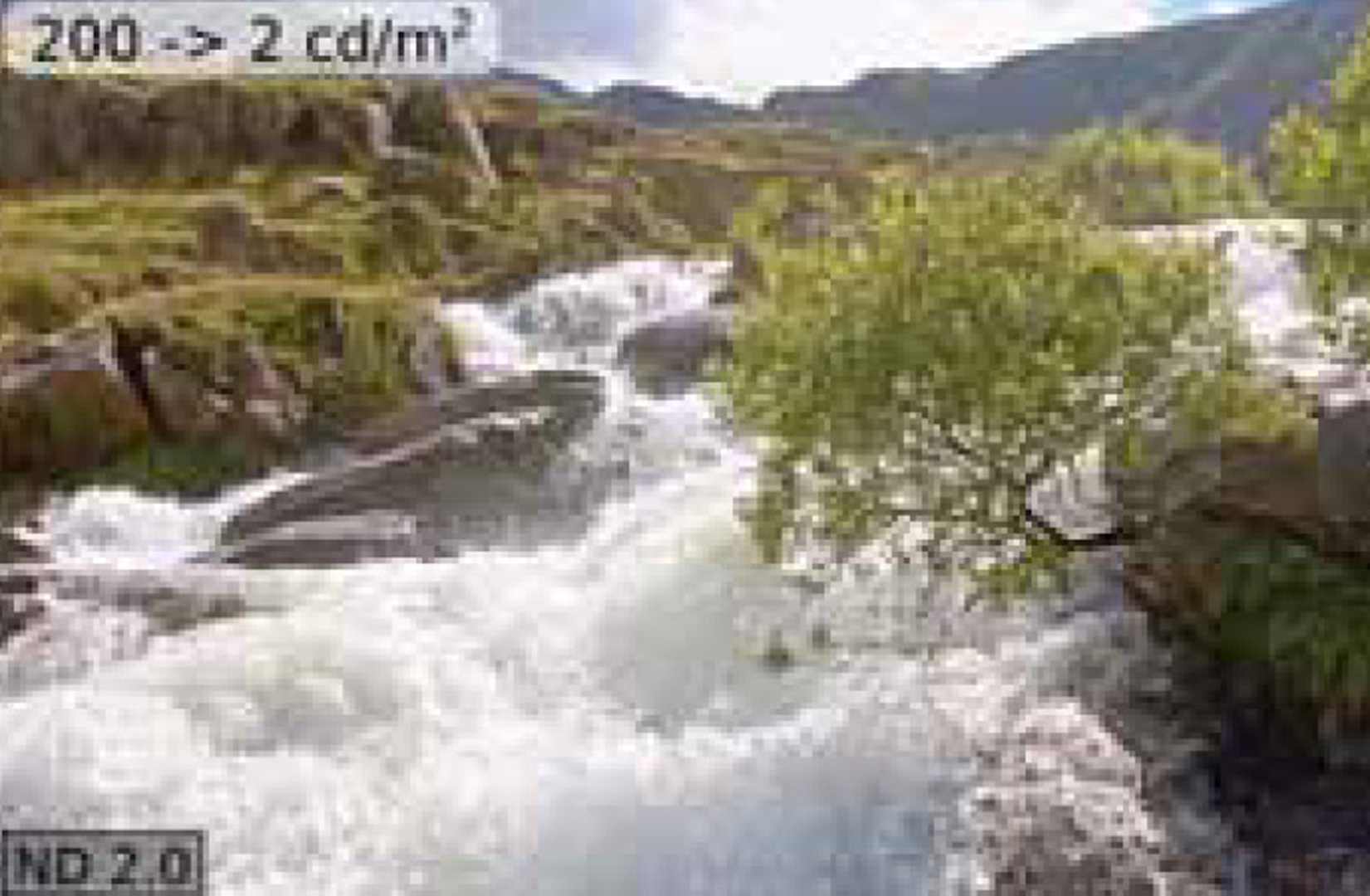“Simulating and compensating changes in appearance between day and night vision” by Wanat and Mantiuk
Conference:
Type(s):
Title:
- Simulating and compensating changes in appearance between day and night vision
Session/Category Title: Changing Your Perception
Presenter(s)/Author(s):
Moderator(s):
Abstract:
The same physical scene seen in bright sunlight and in dusky conditions does not appear identical to the human eye. Similarly, images shown on an 8000 cd/m2 high-dynamic-range (HDR) display and in a 50 cd/m2 peak luminance cinema screen also differ significantly in their appearance. We propose a luminance retargeting method that alters the perceived contrast and colors of an image to match the appearance under different luminance levels. The method relies on psychophysical models of matching contrast, models of rod-contribution to vision, and our own measurements. The retargeting involves finding an optimal tone-curve, spatial contrast processing, and modeling of hue and saturation shifts. This lets us reliably simulate night vision in bright conditions, or compensate for a bright image shown on a darker display so that it reveals details and colors that would otherwise be invisible.
References:
1. Barten, P. G. J. 1999. Contrast sensitivity of the human eye and its effects on image quality. SPIE Press.Google Scholar
2. Bartleson, C. J., and Breneman, E. J. 1967. Brightness Perception in Complex Fields. Journal of the Optical Society of America 57, 7, 953–956.Google ScholarCross Ref
3. Berns, R. S. 1996. Methods for characterizing crt displays. Displays 16, 4, 173–182.Google ScholarCross Ref
4. Brady, N., and Field, D. J. 1995. What’s constant in contrast constancy? The effects of scaling on the perceived contrast of bandpass patterns. Vision Research 35, 6, 739–756.Google ScholarCross Ref
5. Cao, D., Pokorny, J., Smith, V. C., and Zele, A. J. 2008. Rod contributions to color perception: linear with rod contrast. Vision Research 48, 26, 2586–92.Google ScholarCross Ref
6. Chang, N., Choi, I., and Shim, H. 2004. DLS: Dynamic backlight luminance scaling of liquid crystal display. IEEE Trans. on Very Large Scale Integration Systems 12, 8, 837–846. Google ScholarDigital Library
7. Eilertsen, G., Wanat, R., Mantiuk, R. K., and Unger, J. 2013. Evaluation of Tone Mapping Operators for HDR-Video. Computer Graphics Forum 32, 7 (Oct.), 275–284.Google ScholarCross Ref
8. Fairchild, M. D. 2005. Color Appearance Models, 2nd ed. John Wiley & Sons.Google Scholar
9. Georgeson, B. Y. M. A., and Sullivan, G. D. 1975. Contrast constancy: deblurring in human vision by spatial frequency channels. The Journal of Physiology 252, 627–656.Google ScholarCross Ref
10. Iranli, A., Lee, W., and Pedram, M. 2006. Backlight dimming in power-aware mobile displays. In Proc. of the Annual Conference on Design Automation – DAC ’06, 604–607. Google ScholarDigital Library
11. Irawan, P., Ferwerda, J., and Marschner, S. 2005. Perceptually based tone mapping of high dynamic range image streams. In Proc. of EGSR, 231–242. Google ScholarDigital Library
12. Kane, J. P., and Kurtz, F. A., 2012. Adapting display color for low luminance conditions. Patent app. EP 2526688 A1.Google Scholar
13. Kerofsky, L., and Daly, S. 2006. Brightness preservation for LCD backlight dimming. Journal of the Society for Information Display 14, 12, 1111–1118.Google ScholarCross Ref
14. Kirk, A. G., and O’Brien, J. F. 2011. Perceptually based tone mapping for low-light conditions. ACM Trans Graph 30, 4, 42:1–42:10. Google ScholarDigital Library
15. Kuang, J., Johnson, G., and Fairchild, M. 2007. iCAM06: A refined image appearance model for HDR image rendering. Journal of Visual Communication and Image Representation 18, 5, 406–414. Google ScholarDigital Library
16. Kulikowski, J. J. 1976. Effective contrast constancy and linearity of contrast sensation. Vision Research 16, 12, 1419–31.Google ScholarCross Ref
17. Mantiuk, R., Daly, S., and Kerofsky, L. 2008. ACM Trans Graph 27, 3, 68:1–68:10. Google ScholarDigital Library
18. Mantiuk, R., Mantiuk, R. K., Tomaszewska, A., and Heidrich, W. 2009. Color correction for tone mapping. Computer Graphics Forum 28, 2, 193–202.Google ScholarCross Ref
19. Mantiuk, R., Kim, K. J., Rempel, A. G., and Heidrich, W. 2011. HDR-VDP-2: A calibrated visual metric for visibility and quality predictions in all luminance conditions. ACM Trans Graph 30, 4, 40:1–40:14. Google ScholarDigital Library
20. Moroney, N., Fairchild, M., Hunt, R., Li, C., Luo, M., and Newman, T. 2002. The CIECAM02 color appearance model. In Proc. IS&T/SID 10th Color Imaging Conference, Society for Imaging Science and Technology, 23–27.Google Scholar
21. Pattanaik, S. N., Ferwerda, J. A., Fairchild, M. D., and Greenberg, D. P. 1998. A multiscale model of adaptation and spatial vision for realistic image display. In Proc. of SIGGRAPH ’98, 287–298. Google ScholarDigital Library
22. Peli, E. 1990. Contrast in complex images. Journal of the Optical Society of America A 7, 10, 2032–2040.Google ScholarCross Ref
23. Petit, J., and Mantiuk, R. K. 2013. Assessment of video tone-mapping: Are cameras S-shaped tone-curves good enough? Journal of Visual Communication and Image Representation 24, 1020–1030. Google ScholarDigital Library
24. Reinhard, E., Pouli, T., Kunkel, T., Long, B., Ballestad, A., and Damberg, G. 2012. Calibrated image appearance reproduction. ACM Trans Graph 31, 6, 201:1–201:11. Google ScholarDigital Library
25. Smith, V. C., and Pokorny, J. 1975. Spectral sensitivity of the foveal cone photopigments between 400 and 500 nm. Vision Research 15, 2, 161–171.Google ScholarCross Ref
26. Thompson, W., Shirley, P., and Ferwerda, J. 2002. A spatial post-processing algorithm for images of night scenes. Journal of Graphics Tools 7, 1, 1–12. Google ScholarDigital Library
27. Vos, J. J., and van den Berg, T. J. 1999. CIE 135/1-6 Disability Glare. Tech. rep.Google Scholar
28. Witkin, A. 1984. Scale-space filtering: A new approach to multi-scale description. In IEEE Int. Conf. on Acoustics, Speech, and Signal Processing, vol. 9, 150–153.Google ScholarCross Ref




